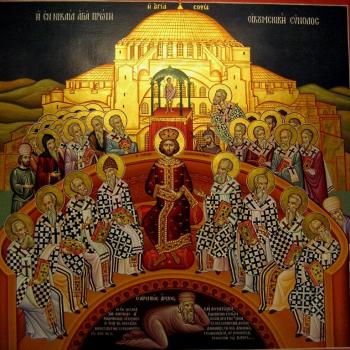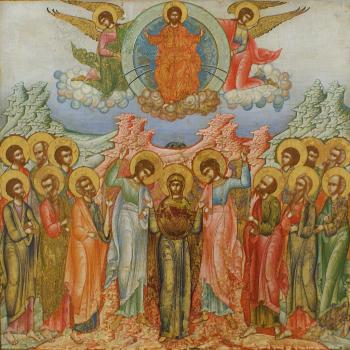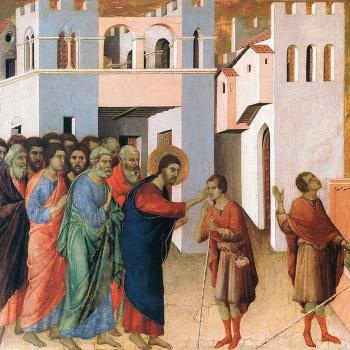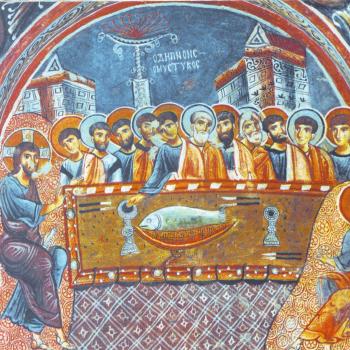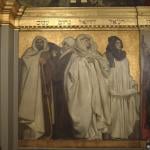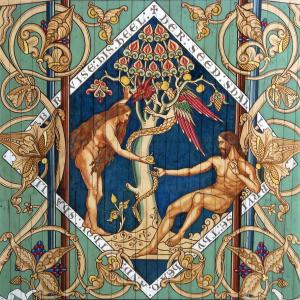
Humanity is in this world together. We might try to avoid reality. We might try to split off from each other, but in the end, we can’t. We are one. We need each other. We can’t do everything ourselves. What one person does will directly or indirectly affect everyone else. Recognizing this is a necessary precondition for us to truly grasp the meaning of original sin and the way Christ save us from its effects (as well as the effects of actual sin). The origin or cause of original sin can be understood in a variety of ways. Some of them require us taking the story of Adam and Eve extremely literal, that is, seeing the story of Genesis as bring primarily a historical story instead of a mythological one. However, not all takes require this interpretation. Others look at Genesis as being a mythological story explaining something which happens to and for all humanity; they see that unity of humanity allows us to designate that united humanity with its own label, one which Scripture gives us with the name of Adam. They see the story of Genesis somehow represents a truth concerning the way humanity establishes itself in the world, and so, as a way of describing the way humanity turns its back on God, turning away from the grace it needs for its own preservation. It is possible to combine both takes. What is necessary is that we recognize that we have been adversely affected by the sins of others, even as they have been affected by ours. What one person does affects us all and changes the conditions in which we find ourselves. What we are told, however, is that there is not only the old, fallen Adam. There is the new, restored Adam, the new, restored humanity. It cannot heal itself from its own self-made wounds, but what remains of it, the good which still exists within it despite its sins, can be taken in by God in the incarnation, creating a new focal point for humanity. That is, while humanity has been affected by sin, causing its historical reality to be conditioned by such sin, it is also something which can be taken in and collected as a whole brought beyond the corruption into a new synthesis, that is, in the New Adam.
Original sin relates to the condition, and the conditioning, we find ourselves as we are born into the world. That conditioning comes to us as a result of what the rest of humanity has done with their lives, with their sins affected humanity as a whole, causing us to come into the world, not with the perfection God intended for us, but rather, in a state cut off from deifying grace. This is what it means to say humanity, and indeed, the world affected by humanity and its sin is fallen. We are born in the world in a fallen state. It is important to recognize it is a state, for it is important to recognize that despite our fall, human nature remains good in and of itself. We just do not even engage the fullness of our human nature. We are cut off from ourselves due to our sin. Humanity has taken the good of its nature and abused it, turning it inside-out and upside-down so that some of that good now has become, as it were, the foundation for our fallen state, and the evil which we will. That evil influences us both in our thinking and in our desires. Again, this means we are born into the world shaped by the influence and corruption of sin. It is important to recognize that formation does not mean we have personally sin, per se, but rather that humanity as a whole has sinned, and we, as human persons, feel the effects of that collective sin. But, in another sense, we have a share in that corruption, that is, we also can be seen as influencing the production of original sin. This is done in and through every time we actually sin. All our sins come together with the sins of everyone else in the creation of original sin and the conditioning it creates for us and the world around us. And in this way, we can find in and of ourselves, in our own sins, that we become, as it were, the Adam represented in the story of Genesis. We become the one whose sins has infected the world, and in this fashion, we become the one whose sin will need to be judged and condemned:
But we are wretched sinners, yes, and our putrid works follow after us as well. These works are indelibly written in the book of fates [cf. Rev. 20:13], yet their impact extends beyond the borders of this human life. They enter into the fates of all human beings, in the history of all humanity, and upon each one of us hangs the fate of the entire world. We must pull back neither from participation nor from responsibility, and until the end of human history our works will endure. For this reason the Dread Judgment will occur simultaneously over all humanity, and each has lived the life of all humanity, each of the sons of Adam is the entire, ancient Adam. [1]
This is what makes it extremely difficult to talk about a historical time in which original sin first occurred because humanity contains within it a transcendent reality, a reality which transcends time, one which connects it all together so that what someone does in one point of time can and will affect humanity in every other point of human history, past, present, or future. We participate in and experience original sin in ourselves. Indeed, it can also be said, the Genesis story is repeated in and by us the first time we actually sin, so that we create original sin which affects everyone else by our own sin. Original sin can be said to be seen as the collective first sin of everyone, and not just something which happened in the past, with a historical Adam and Eve. We participate in it through our sin, even as we are influenced and shaped by the sin of everyone else.
This is why original sin is very difficult to truly tie down and explain. We can’t point to just one event in time and space suggesting that event alone is when original sin was established. It is established throughout time and yet, because it affects the whole of humanity is its transcendent nature, it is not merely temporal. However, we often think of it merely as temporal because we think of cause and effect in a temporal fashion. It is extraordinarily difficult for us to apprehend trans-temporal causality, and so, it is difficult for us to understand original sin. This is why we generally treat it simply as a historical event, giving it an apparently historical foundation, reading the story of Genesis as a way to find that historical event. But, because the truth of original sin goes beyond such temporal causality, we should understand there is something mythic, and not merely historical, in the story of Genesis. Whether or not there was a historical Adam is not the point of the story. What is important is to see in the myth the presentation of the transhistorical Adam, the collective humanity in which we have a part, and so see how we have a part in the establishment of original sin. It is important to recognize the fact that sin, by its corruptive nature, already works to corrupt our state of being by having us disconnect ourselves from our transcendent reality, from the good or perfection found in our nature and its proper relationship with God. It does this so that it can continue on hurting us, leading us to further and further corruption, until we find ourselves lead to our own destruction, that is, to a nihilistic void which consumes us and our existence. Original sin does this, in part, by using our collective sin, having us, in our particular experience of it, find ourselves disconnecting ourselves from the rest of humanity, so that we become individuals cut off from each other, fighting each other for what good we find left in the world:
This powerful result of original sin, dark, irrational, malign, has its seat in the depths of man’s being. It hides there and moves in the secret places of the soul, and we are often unconscious of it. It is that which cuts off each individual from all other persons and things, shutting him up in himself, making him as it were impervious to others; it is a maniacal force, the principle of all folly, which by isolating each one of us severs our ties with the spiritual world, deprives us of all fellowship, and blinds us to our true relationship with the universe, which is the veritable reason (ratio) for our existence. Accordingly, we conjure up the image of a special world of our own and insanely take this fantasy for reality. [2]
The new Adam, the new integral or restored humanity found in Christ, is able to take the old humanity with its sin and cut it off from its sin. It takes the good which remains despite such sin can and reorients it towards the transcendent truth and goodness which it needs so that it can find itself no longer being oriented to the void but to the eternal kingdom of God. The second Adam, the incarnate God-man Jesus, takes upon himself the first Adam, making it his. He does so in such a way that he comes from outside the collective guilt of original sin (having no sin him himself), so that he comes with the proper relationship with God that original sin had humanity lose, bringing it back to humanity, giving it, therefore, the grace which original sin had undermined. By creating in and of himself a new center for humanity, a new Adam, an undefiled Adam, humanity does not have to find itself eternally configured to sin and the annihilation it brings; rather, humanity can now find its eternal existence is on which is configured to the divine life, one which makes it deified by grace as it finds its relationship with God gives it a share in the divine life itself. It is this reorientation towards God, with the grace that God gives in it, which is necessary for humanity, and all the world, to overcome its collective guilt, that is, original sin.
And so, to restate: Sin cuts up and destroys humanity. Christ takes what is found, what is left of the old humanity, what sin has not yet destroyed, and uses that to restore what was lost. It is what allows him to bring everyone back to their proper relationship with God. Thus Bulgakov says that we can see the effects of original in in the way history shows us the damage done by sin, that is, in the way humanity divides itself from itself, creating individuals struggling against each other, while the eschaton reveals the end of sin and its influence, so that in the eschaton, everything is brought together as one so that even what was lost in time can be restored and find it has a place in eternity:
History is a broken mirror, which reflects the image of God in man in a distorted and fragmented manner. The universal “apocatastasis” consists in restoring this integral image, in uniting its fragment for its definitive revelation beyond history. The character of this path, broken and with no escape, is determined by original sin, the source of the human tragedy.[3]
Christ has taken up human nature and shown it the good it has within itself, the good which remains despite the corruption of sin. It is wounded by our own transgressions. It is this wound which Christ himself feels in his humanity, while as the divine Logos, Christ comes into the world as the Good Samaritan, as the one who comes from outside, who, having seen our wounds, does what he can to heal us:
For the Samaritan is the Son of God, made incarnate in the shrine of the Holy Spirit, that is, in the immaculate Virgin, without any of the blindness of Adam, which human nature has as a result of sin. And He raised Adam and all his race from the pit of hell. [4]
While we can and should discern the effects of original sin in history, that is, in the ways humans adversely treats each other, and so, realize the truth being taught by the doctrine of original sin, we must be careful in how we interpret that doctrine. We must not let sin be reified, turned into a substance, for that will not allow us to properly understand how sin is overcome by Christ. Likewise, then, original sin (which is not actual sin) is also not a substance. It is rather the name we give to the corruption we experience as the result of the collective sin of humanity and the way that corruption affects the way we first come into the world. Without the incarnation, sin would rule, for humanity would not have what it needs to get beyond the destructive power of sin. It would find itself in a continuous loop where sin leads to corruption, and through that corruption, lead people to sin some more, until at last, nothing would be left as the corruption leads humanity to its own self-destruction. As sin is not a substance, as original sin is not a substance, when that destruction takes place, there will be nothing left. But the incarnation took place. Christ assumed humanity, providing to it an end to its self-destruction. Now, instead of being oriented to the nihilistic void, the dark inversion of the nothing which transcends creation, humanity can find itself oriented to the kingdom of God, and with it, eternal life. The story of Christ, the Gospel, is the good news that original sin, and with it, all sin has an end, while the kingdom of God does not.
[1] Sergius Bulgakov. Spiritual Biography. Trans. Mark Roosien and Roberto J. De La Noval (Brooklyn, NY: Angelico Press, 2022), 149-50 [10/23.V.1925].
[2] Vladimir Solovyey, God, Man & The Church. The Spiritual Foundations Of Life. Trans. Donald Attwater (Cambridge: James Clarke & Co., 2016), 21.
[3] Sergius Bulgakov, Bride of the Lamb. Trans. Boris Jakim (Grand Rapids, MI: William B. Eerdmans Publishing Company, 2002), 189.
[4] St. Hildegard of Bingen, “Letter 164r” in The Letters of Hildegard of Bingen. Volume II. Trans. Joseph L Baird and Radd K Ehrman (Oxford: Oxford University Press, 1998), 116.
Stay in touch! Like A Little Bit of Nothing on Facebook.
If you liked what you read, please consider sharing it with your friends and family!
N.B.: While I read comments to moderate them, I rarely respond to them. If I don’t respond to your comment directly, don’t assume I am unthankful for it. I appreciate it. But I want readers to feel free to ask questions, and hopefully, dialogue with each other. I have shared what I wanted to say, though some responses will get a brief reply by me, or, if I find it interesting and something I can engage fully, as the foundation for another post. I have had many posts inspired or improved upon thanks to my readers.



